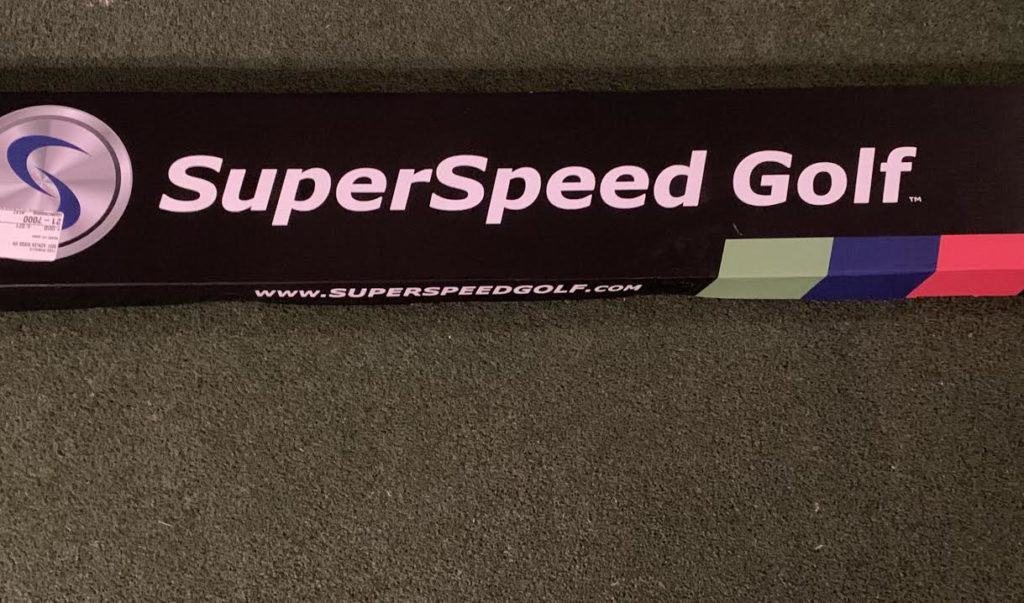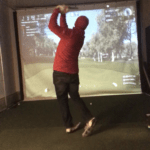The iron swing will be different from the driver swing due to the length of the club and precision required for the two different shots. Some people have tried single length irons to remove the variation from iron to iron, but there is still a difference between the iron swing and driver swing.
Golf is a challenging game. It can be quite rewarding and serves as an amazing journey to play your best!
One of the greatest challenges that most golfers face is being sharp with all 14 clubs in the bag.
We all have rounds where we hit the driver well, but maybe struggle with the irons. Or the days where we hit the driver and irons well, but can’t seem to make a putt.
Golf has its way to finding and exposing your weaknesses during that round of golf. Over the course of 18 holes and 4 hours, we are challenged to hit a variety of shots with each of the 14 clubs in our bag.
This is what makes golf so amazing in my opinion.
You have to stay strong both physically and mentally for 4 hours and continue to hit shot after shot. A true round of golf, where you shoot your best score, is a journey in itself. One full of challenges and barriers to play your best.
A question we often receive is if the iron swing is different than the driver swing.
Update: Make sure you spend time learning to keep your driver in play with above average distance, while being able to hit the green with those irons. They are different swings with somewhat different intentions.

Iron vs Driver Swing in Golf (Overview)
Below, I will dive into the differences and the similarities between the iron vs driver swing.
Difference #1: Iron vs Driver Swing (Club Length)
The single greatest difference is the length of the driver. The driver is a 45 inch club that is lightweight and produces the highest swing speed of any club in the bag. The average tour pro swings their driver 113 miles per hour, while many top amateurs swing around 105 miles per hour.
The overall length of the driver and the lightness of the club is designed to produce distance and carry the ball as far as possible. The overall accuracy isn’t as near as important as with an iron.
As a result of the club length difference, the driver swing is naturally more rounded than a swing with a short iron. If you had a club tracing tool, you should see the club swing in a more circular motion.
Driver vs 3 Wood (complete overview here)
Difference #2: Iron vs Driver Swing (Angle of Attack)
The second main difference is the angle of attack. With a driver, most amateurs are instructed to swing up on the ball. So the golfer is standing there with a 45 inch club, ball teed up, swinging their fastest and trying to hit up on the ball.
How far should I hit my driver?
The angle of attack is a positive number to help launch conditions and to reduce the amount of backspin. There is a major difference in total carry distance between a shot that has 105 mph swing speed and 2400 RPM spin rate vs a 105 mph swing speed with a 4000 spin rate.
The lower amount of spin would carry around 20-30 yards further. This alone has a major difference in how the club is swung.
Take a short iron to compare. The golfer is standing there with a 9 iron, which is only 36 inches long on average, trying to hit a ball within a 20 foot circle of the pin. The golfer is often trying to hit down on the ball to produce spin and ensure clean contact.

Difference #3: Iron vs Driver Swing (Setup)
As a result of the longer driver and the angle of attack, the golfer is going to setup different with an iron vs the driver. The driver is going to have the ball more towards the front foot, with the upper body slightly leaning towards the back leg.
This helps maximize the launch conditions and the angle of attack. We also know that for most amateur hitting down on a driver will rob the golfer of total distance due to spin rate and maximizing launch angle.
Why can’t I hit my driver? 5 common swing faults!
Difference #4: Iron vs Driver Swing (Intention)
The final difference is the intention or outcome of both swings. When hitting a driver, the key is to hit the ball far and somewhat straight. I saw somewhat straight because as we have witnessed in recent years on the PGA Tour, hitting the ball long is vital to winning tournaments.
Even for most amateurs, being in the fairway with 170 left or being in the rough with 120 left, the shot from 120 out of the rough is more manageable. Hit it long and far to give yourself the best chance!
Similarity #1: Iron vs Driver Swing (Overall Motion)
The golfer’s overall motion and movement of hips, shoulders, legs and arms are going to stay very similar from club to club in the bag. If you put a driver in the hands of Tiger Woods and then also put an iron in his hands, the motion is going to look almost naturally the same.
Your overall motion in your swing is the DNA of your swing and you want to work on this same motion from swing to swing.
Continuing to work on your overall motion and the use of your legs, hips, shoulders and arms in the swing will help you improve as an iron player and a driver of the golf ball. The more solid you can make your overall motion, the better you will be all around.
The simple setup adjustments and mindset shifts over the different clubs will come more naturally and you will feel more comfortable over the shot!

Similarity #2: Iron vs Driver Swing (Tempo)
The overall tempo of your swing should remain the same. In fact, from the study completed by Tour Temp and John Novosel Jr., we know that the best swings have a 3:1 ratio.
This means 3 parts back to 1 part downswing. Whether a golfer is hitting a driver or 7 iron, this tempo will remain the same, which is beneficial to the golfer when it comes to timing and tempo.
When you get to the wedges, you may see more of a 2:1 tempo, but for the most part with irons vs driver, you will find the best golfers have a 3:1 ratio in their tempo. Don’t buy into the low and slow approach that we heard for all those years. If you want to hit further, swing faster and find your 3:1 ration.
To learn more about Tour Tempo and to read a review, check out this post.
Similarity #3: Iron vs Driver Swing (Shaping Shots)
The best golfers are able to hit their stock shot with an iron or driver. I would recommend building a stock shot and hitting it with the iron and drivers.
The best golfers are able to hit a draw or a fade under pressure and understand what is takes to pull the shot off. I prefer to hit the stock draw with both the irons and driver because I know that 9 times out of 10 my ball will start slightly right and draw back towards the target.
If you need a drill to build a stock shot. Check out this drill below:
- At the driving range, set up an alignment stick about 6-8 yards in front of you, straight down your target line.
- If you have a second alignment stick, set the stick 3-4 yards right of the first stick (for a draw) or left of the first stick (for a fade).
- Complete your initial assessment see how many times out of 10 you can start the ball to the right or left of your target. Pick one side and measure your game at this point.
- The goal is to eventually get 7 out of 10 shots to start to the correct side and draw back towards the target.
For a complete post on developing a stock shot, visit here.
Here is the drill being explained by Kyle Morris:
*I enjoy doing this drill in my golf simulator setup as I can see the curve of the ball and the spot where my ball hit on the impact screen. However, it can easily be utilized at the driving range. See below for more from rotation about my golf simulator setup!
How to hit a driver 300 yards.
Similarity #4: Iron vs Driver Swing (Speed Matters)
Whether you are hitting a driver or iron, speed matters. The analytics have become clear on the importance of overall distance. Make sure you are training for extra speed. The ability to hit a driver 280 plus yards or to be able hit an 8 iron, 160 yards is a game changer.
We all want more swing speed in our golf game. Many of us have read or heard about the analytics related to golf and the importance of additional speed and distance in our game. If you can’t hit the ball over 225 yards with the driver, reaching certain levels like low single digits can be difficult.
The good news is that there are numerous options to help you improve your swing speed regardless of age. The most recent science to hit golf is the overspeed training.
The most popular and the one that I use is SuperSpeed Golf. This overspeed training approach has multiple training protocols that only take 15 minutes every other day.
Find a place at your house where you can swing the speed sticks and gain 5-8% as early as the first training session. Make this stick and become your normal speed by training for several months. Over the course of time, you can expect to add an additional 1% every couple of months on top of the 4-6%.
A year ago my average driving swing speed was between 99-101 miles per hour. I am not playing the game between 103-107 miles per hour. Just the other day I hit two drivers that went 285 yards in some soft, no wind conditions.
This means to me that I really did connect and have been able to add additional speed through the overspeed training and by studying and implementing the swing practices of George Gankas!
Are you ready to get started today with SuperSpeed Golf? Build that stock shot, train for more speed, don’t forget about the short game and before you know you will be shooting your goal score!
- Check out SuperSpeed Overspeed Training Protocols
- Train every other day for 10-15 minutes.
- See a 4-6% increase in swing speed as early as the first training protocol.
The number one thing that has helped me gain significant distance is the SuperSpeed Training System.

BONUS TIP: Measure Your Swing
The great thing about golf in today’s era is that golfers have access to some wonderful technology that can allow them to experiment and figure out what is best for their game. I highly recommend a launch monitor to help you measure what amount of hip rotation is best for your game.
Know your numbers with a driver and each of your irons. Having access to this information is a game changer!
In today’s golf world, the access to affordable launch monitors is a complete game changer. Not only can one help you set up your experiment with different swings and philosophies, but it can also help you map your bag by knowing the distance you carry each club.
One could try out the different methods of instruction found above and use the launch monitor to measure for success. Some areas you will want to monitor include:
- Start line consistency
- Amount of side spin
- Ball speed
- Carry distance
A Launch Monitor is a great addition to your practice sessions even beyond determining what hip movement is best for your game.
Stop guessing on your ball and club data and get the immediate feedback that you need to improve your game. Club selection and the makeup of your bag is often overlooked by many amateurs.
The professional golfers of today all have access to some great technology including launch monitors to help measure their swing and know their numbers. Can an amateur use this same or similar technology for game improvement?
Yes, absolutely and I would highly recommend it.
Even if you aren’t going to go all out and build an indoor golf simulator like I did (see below), you can still pick up a launch monitor at a reasonable price and use it in your indoor net or taking to the course or driving range with you!
Knowing numbers like spin rate, ball speed, spin axis and other key information is vital to your growth. Sharing these numbers with your instructor can be helpful and help with equipment selection as well. This will help you select the right clubs for your bag and when to add that extra hybrid or wedge.
I would recommend one of the three launch monitors listed below:
My Secret To Golf Improvement
Let’s face it, in order to get really good at golf, we must practice frequently. About three years ago, I made the leap and invested in a golf simulator build for my garage.
I went with a SkyTrak Launch Monitor and the TGC software and can now play over 100,000 courses including Augusta, Pebble Beach, Bethpage Black, Whistling Straits. St. Andrews and many other of the top 100 courses in the world.
This golf simulator setup, which is more affordable that you might imagine, has been a game changer. I can now play golf everyday of the year regardless of rain, snow, cold weather or time of day.
I can practice or play rounds of golf. I can stand in the 11th fairway at Augusta and with the auto-rewind feature I am able to practice my approach shots from various differences.
It is worth checking out through Rain or Shine Golf as they offer some incredible packages along with financing offers that are difficult to beat.
Some direct links to Rain or Shine Golf for pricing and financing:

Take Action – What You Can Do Today to Get Better
What does this mean for you? I believe in the following recipe to get better:
1 – Improve your motion in the golf swing by identifying a golf instructor. Here are some options:
Here is a list of golf instructors that we have reviewed:
2 – Train to swing faster and improve your swing speed. Here are some options:
Looking to gain more Speed and Distance in your swing. Two Options:
3 – Understand course strategy and work to break through your next barrier. Here is a series on breaking through:
We have provided guides on how to break 100, 90, 80 and 70. Check out more below, if interested.
4 – Practice Frequently
Did you know that I build a golf simulator in my garage and have played over 500 rounds of golf on my SkyTrak system? It has been a game changer and one worth checking out. Here are some of my other posts on golf simulators frequently asked questions:
- Is a Golf Simulator Worth It?
- How to Build a Golf Simulator?
- What is the Best Golf Simulator?
- Golf Simulator Accessories?
- How to Build a Golf Simulator for under $7000
- Top 11 Reasons to Buy a SkyTrak
- How to Build a Golf Simulator for Under $1000
- Why Build A Golf Simulator?
- What Space is Needed?
- Can A Golf Simulator Improve My Game?
- How Much Does A Golf Simulator Cost?
- Don’t Forget to Check out our 15 best golf swings of all time.
I am an amateur golfer on a journey to get better, enjoy the game as often as possible and share my passion and knowledge with others. I have coached high school golfers at a high level and have a great passion for the game and want to give back. I enjoy learning about the golf swing and am currently studying to be a certified professional golf instructor. Join me in our journey to get better everyday. Thank you for reading!

